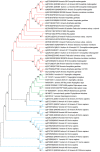Proteome of the Triatomine Digestive Tract: From Catalytic to Immune Pathways; Focusing on Annexin Expression
- PMID: 33363206
- PMCID: PMC7755933
- DOI: 10.3389/fmolb.2020.589435
Proteome of the Triatomine Digestive Tract: From Catalytic to Immune Pathways; Focusing on Annexin Expression
Abstract
Rhodnius prolixus, Panstrongylus megistus, Triatoma infestans, and Dipetalogaster maxima are all triatomines and potential vectors of the protozoan Trypanosoma cruzi responsible for human Chagas' disease. Considering that the T. cruzi's cycle occurs inside the triatomine digestive tract (TDT), the analysis of the TDT protein profile is an essential step to understand TDT physiology during T. cruzi infection. To characterize the protein profile of TDT of D. maxima, P. megistus, R. prolixus, and T. infestans, a shotgun liquid chromatography-tandem mass spectrometry (LC-MS/MS) approach was applied in this report. Most proteins were found to be closely related to metabolic pathways such as gluconeogenesis/glycolysis, citrate cycle, fatty acid metabolism, oxidative phosphorylation, but also to the immune system. We annotated this new proteome contribution gathering it with those previously published in accordance with Gene Ontology and KEGG. Enzymes were classified in terms of class, acceptor, and function, while the proteins from the immune system were annotated by reference to the pathways of humoral response, cell cycle regulation, Toll, IMD, JNK, Jak-STAT, and MAPK, as available from the Insect Innate Immunity Database (IIID). These pathways were further subclassified in recognition, signaling, response, coagulation, melanization and none. Finally, phylogenetic affinities and gene expression of annexins were investigated for understanding their role in the protection and homeostasis of intestinal epithelial cells against the inflammation.
Keywords: annexin; chagas disease; digestive tract; enzymes; immunity; mass spectrometry; triatomine.
Copyright © 2020 Gumiel, Mattos, Vieira, Moraes, Moreira, Gonzalez, Teixeira-Ferreira, Waghabi, Azambuja and Carels.
Conflict of interest statement
The authors declare that the research was conducted in the absence of any commercial or financial relationships that could be construed as a potential conflict of interest.
Figures








Similar articles
-
Metabolic signatures of triatomine vectors of Trypanosoma cruzi unveiled by metabolomics.PLoS One. 2013 Oct 30;8(10):e77283. doi: 10.1371/journal.pone.0077283. eCollection 2013. PLoS One. 2013. PMID: 24204787 Free PMC article.
-
Panstrongylus geniculatus and four other species of triatomine bug involved in the Trypanosoma cruzi enzootic cycle: high risk factors for Chagas' disease transmission in the Metropolitan District of Caracas, Venezuela.Parasit Vectors. 2014 Dec 23;7:602. doi: 10.1186/s13071-014-0602-7. Parasit Vectors. 2014. PMID: 25532708 Free PMC article.
-
Comparative and functional triatomine genomics reveals reductions and expansions in insecticide resistance-related gene families.PLoS Negl Trop Dis. 2017 Feb 15;11(2):e0005313. doi: 10.1371/journal.pntd.0005313. eCollection 2017 Feb. PLoS Negl Trop Dis. 2017. PMID: 28199333 Free PMC article.
-
Insecticide resistance in vector Chagas disease: evolution, mechanisms and management.Acta Trop. 2015 Sep;149:70-85. doi: 10.1016/j.actatropica.2015.05.014. Epub 2015 May 21. Acta Trop. 2015. PMID: 26003952 Review.
-
What makes an effective Chagas disease vector? Factors underlying Trypanosoma cruzi-triatomine interactions.Acta Trop. 2018 Jul;183:23-31. doi: 10.1016/j.actatropica.2018.04.008. Epub 2018 Apr 3. Acta Trop. 2018. PMID: 29625091 Review.
Cited by
-
The Fate of Dietary Cholesterol in the Kissing Bug Rhodnius prolixus.Front Physiol. 2021 Apr 1;12:654565. doi: 10.3389/fphys.2021.654565. eCollection 2021. Front Physiol. 2021. PMID: 33868022 Free PMC article.
-
Early Post-Prandial Regulation of Protein Expression in the Midgut of Chagas Disease Vector Rhodnius prolixus Highlights New Potential Targets for Vector Control Strategy.Microorganisms. 2021 Apr 11;9(4):804. doi: 10.3390/microorganisms9040804. Microorganisms. 2021. PMID: 33920371 Free PMC article.
-
Expression of Proteins, Glycoproteins, and Transcripts in the Guts of Fasting, Fed, and Trypanosoma cruzi-Infected Triatomines: A Systematic Review.Pathogens. 2023 Sep 2;12(9):1124. doi: 10.3390/pathogens12091124. Pathogens. 2023. PMID: 37764932 Free PMC article. Review.
-
Trypanosoma cruzi/Triatomine Interactions-A Review.Pathogens. 2025 Apr 17;14(4):392. doi: 10.3390/pathogens14040392. Pathogens. 2025. PMID: 40333244 Free PMC article. Review.
-
Interaction of Trypanosoma cruzi, Triatomines and the Microbiota of the Vectors-A Review.Microorganisms. 2024 Apr 25;12(5):855. doi: 10.3390/microorganisms12050855. Microorganisms. 2024. PMID: 38792688 Free PMC article. Review.
References
-
- Albuquerque-Cunha J. M., Gonzalez M. S., Garcia E. S., Melllo C. B., Azambuja P., Almeida J. C. A., et al. (2009). Cytochemical characterization of microvillar and perimicrovillar membranes in the posterior midgut epithelium of Rhodnius prolixus. Arthropod. Struct. Dev. 38 31–44. 10.1016/j.asd.2008.06.001 - DOI - PubMed
-
- Araújo C. A., Waniek P. J., Stock P., Mayer C., Jansen A. M., Schaub G. A. (2006). Sequence characterization and expression patterns of defensin and lysozyme encoding genes from the gut of the reduviid bug Triatoma brasiliensis. Insect. Biochem. Mol. Biol. 36 547–560. 10.1016/j.ibmb.2006.04.003 - DOI - PubMed
LinkOut - more resources
Full Text Sources
Research Materials

